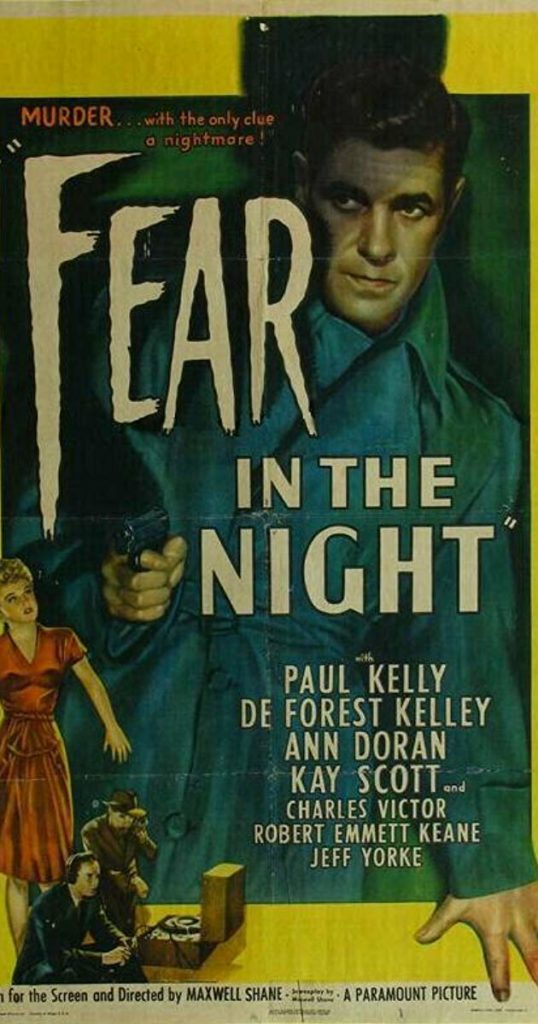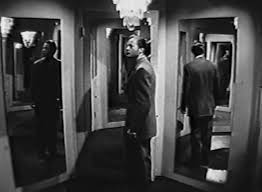IMDb meta-data is run time of 1 hour and 12 minutes, rated 6.4 by 1192 cinematizens. (I do worry about some cinematizens when I see ratings like this.)
Genre: noir

Verdict: Oh hum.
In his first feature film a rake-thin Dr Leonard McCoy has a bad dream and tells the world about it, repeatedly. His Georgia origins are pronounced. (Get it?) He was born Jackson DeForest Kelley. Can you believe any parents would do that?
The dream opens proceedings and it is very well done, with spinning and shadows. In it there is a femme fatale, to be sure, and man bent over a safe in conservatory with four mirrored doors.

A robotic, and so perfectly cast, McCoy emerges from behind one door while the couple are intent on the safe behind another door, and he stabs the man to death while the femme scoots.
He then wakes upon a sweat, and begins to blab, while striving not to blab, he blabs to his brother-in-law of the chiselled chin (Paul Kelly) who laughs it off, slaps him around to straighten him out, and finally begins to think something might have happened. Chin is a copper and he has his ways of finding out things, namely, a slap on the chops. After the pair of them with their wife and girlfriend, respectively, just happen to go on a picnic on the grounds the very mansion possessed of a conservatory with four mirrored doors. Small world.
Sidebar: By now the fraternity brothers had passed out from boredom and beer in equal measure.
Thereafter Kelley and Kelly are on the case. McCoy cries, faints, trembles, and is useless, while Chisel-chin does all the running, thumping, and shooting. As we Noiristas realised from the second act, the harmless little man next door was an evil genius who had hypnotised weak-minded McCoy into hiding in the conservatory closet to surprise the safe cracker and moll.
The moll was Harmless’s wife who was going to run off with the cracksman after he cleaned out Harmless’s safe. Not nice to be sure.
Turns out robot McCoy had no responsibility because the yegg attacked him when he appeared out of nowhere ergo he acted in self defence. Sure, tell that to the judge, which he did. The end.
The dream sequence at the beginning derives from ‘Spellbound’ (1945) and anticipated later imitations. In this outing it lacks the gravitas imparted by Alfred Hitchcock who added doses of Salvador Dali hyper-reality to it in ‘Vertigo’ (1958). Strangely ‘Fear in the Dark’ is not included on the IMDb list of more than a thousand films with a dream sequence, but it does index many Donald Duck cartoons. Did A.I. compile that list?
One of the reviews attached to the IMDb entry – Film Noir of the Week – goes on and on for about 3000 words interpreting the film as a homosexual love story between Chisel-chin and trembling McCoy. Believe it, Ripley! I watched a different movie.
McCoy had just come out of the army and was branching out from his pre-war career as a radio singer. (!) His acting peaked in this outing, though he had a career as a villain in westerns on television before The United Federation of Planets was desperate enough to draft him. He remained robotic.
